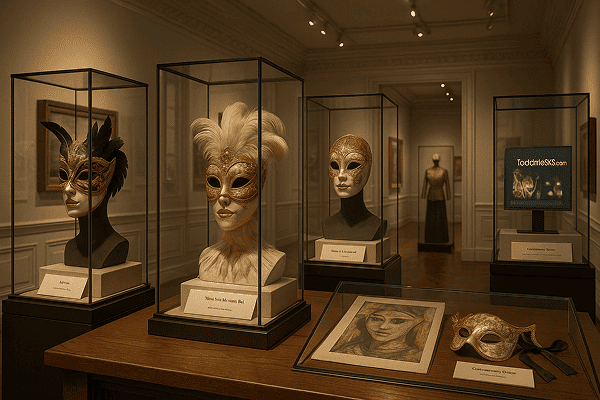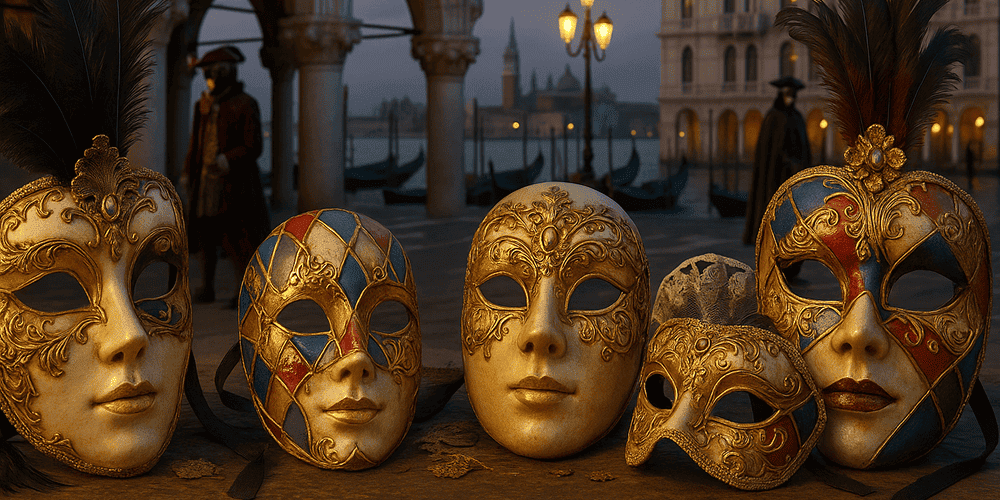The Colombina Mask stands as one of the most elegant and beloved symbols of Venetian masquerade. Instantly recognizable for its delicate half-face design, ornate decorations, and ties to both theatre and carnival, the Colombina Mask embodies the spirit of Venice itself — mysterious, playful, and rich with history. Typically covering only the eyes, nose, and upper cheeks, this mask is often adorned with gold leaf, feathers, jewels, and intricate painting. Originating in Venice during the flourishing of the Commedia dell’Arte in the 16th and 17th centuries, the Colombina Mask is deeply woven into the cultural tapestry of Italy and, more specifically, the Veneto region.
Historical Origins: The Emergence of the Colombina Mask
The Colombina Mask traces its origins to the golden age of Venetian theatre. Named after the stock character Colombina — a clever and charming maid — in the Commedia dell’Arte, the mask was originally worn by actresses who wanted to highlight their beauty while maintaining an air of mystery. The word “Colombina” means “little dove” in Italian, reflecting both the innocence and the wit embodied by the character.
Historical sources indicate that the mask first appeared in the late Renaissance, when Venice was renowned for its opulent festivals and thriving stage culture. The mask’s design quickly evolved: while early versions were simple, later examples became increasingly elaborate, reflecting the competitive artistry of Venetian mask-makers. The mask’s popularity spread throughout Europe with touring Commedia troupes, but it remained most closely associated with Venetian Carnival and the city’s unique social life.
Cultural Significance and Symbolism of the Colombina Mask
The Colombina Mask carries a wealth of symbolic meaning in Venetian culture. As a mask that reveals as much as it conceals, it embodies the duality of identity and performance. Traditionally, the mask was worn by women at balls, theatre performances, and secret trysts, allowing the wearer to express flirtatiousness, independence, or intrigue.

In the context of Commedia dell’Arte, the mask signaled the character’s intelligence and resourcefulness, often outwitting her male counterparts. Socially, the Colombina Mask became a tool for navigating Venice’s famously complex social codes, permitting both anonymity and self-expression in a society where class boundaries were otherwise strictly maintained.
Materials and Craftsmanship: How Colombina Masks Are Made
Traditional Colombina Masks are crafted by skilled Venetian “maschereri” (mask-makers) using papier-mâché, leather, or occasionally porcelain. The process begins with sculpting a clay or plaster mold, onto which layers of papier-mâché are applied using natural glues. After drying, the mask is carefully removed from the mold, trimmed, and sanded smooth.
Decoration is where the artistry truly shines: masks are painted with tempera or acrylics, gilded with gold or silver leaf, and embellished with lace, crystals, feathers, and silk ribbons. Each mask is unique, reflecting the creativity of the artisan. Regional workshops in Venice are known for their distinctive styles — some favoring Baroque opulence, others opting for minimalist elegance. Color symbolism is important: white for purity, gold for celebration, and black for sophistication.
Functions and Uses of the Colombina Mask
The Colombina Mask has served many purposes throughout its history. In the Renaissance and Baroque eras, it was a staple of Carnival, worn by revelers seeking both anonymity and glamour. Theatrically, it was central to the portrayal of Colombina and similar characters in Commedia dell’Arte, where actors used masks to amplify expressions and gestures.
Over the centuries, the mask’s use expanded to include masquerade balls, private parties, and even political intrigue. Today, the Colombina Mask remains a highlight of the annual Venice Carnival, worn by both locals and tourists. It is also a popular accessory for costume parties, weddings, and theatrical events worldwide, reflecting the enduring fascination with Venetian tradition.
Regional Variations: The Diversity of Colombina Masks
While the Colombina Mask is most closely associated with Venice, regional variations have emerged across Italy and beyond. Venetian masks tend to be the most ornate, featuring lavish decoration and fine materials. In other parts of Italy, simpler versions are made for local festivals. Internationally, the Colombina Mask has inspired adaptations in France, Spain, and Latin America, often blending local motifs and materials. Compared to other half-masks, such as the French “loup,” the Colombina is distinctive for its theatrical origins and elaborate Venetian style.
Notable Examples and Collections: Where to See Colombina Masks
Some of the world’s most prestigious museums and collections feature outstanding examples of the Colombina Mask. The Museo di Palazzo Mocenigo and Ca’ Rezzonico in Venice hold historic and contemporary masks, while the Victoria and Albert Museum (London) and the Metropolitan Museum of Art (New York) include fine specimens in their costume and theatre collections. Important private collections, sometimes showcased on platforms like toddmasks.com, offer further insight into the evolution and artistry of the Colombina Mask. Noteworthy artifacts include masks worn by famous actresses and those featured in historic Venetian balls.

Influence on Art and Culture: The Colombina Mask Beyond Venice
The Colombina Mask has left an indelible mark on world art, design, and performance. Its stylized silhouette and decorative flourishes appear in paintings, operas, films, and haute couture. The mask’s potent blend of concealment and revelation has inspired countless writers and directors — from Shakespeare to modern cinema. In fashion, elements of the Colombina Mask are echoed in masquerade-themed collections and accessories. Most recently, designers have drawn parallels between the Colombina Mask and iconic forms in other cultures, such as the Japanese Kitsune Masks, both of which symbolize transformation and theatricality.
By appearing in contemporary art, literature, and even pop music, the Colombina Mask remains a dynamic symbol of Venetian creativity and the enduring allure of masquerade.
Contemporary Status and Preservation of the Colombina Mask Tradition
Today, the creation and celebration of Colombina Masks are sustained by master artisans in Venice and elsewhere. Workshops offer classes and demonstrations, passing down centuries-old techniques to new generations. Organizations such as the Associazione Mascherai Veneziani work to protect the authenticity of Venetian mask-making, while events like the Venice Carnival keep the tradition vibrant.
Modern innovations include the use of new materials (such as lightweight resins and LED embellishments) and collaborations with contemporary artists. Educational tours, museum exhibitions, and online resources — including detailed explorations on toddmasks.com — support the preservation and appreciation of the Colombina Mask tradition.
Collecting and Acquiring Colombina Masks
The market for Colombina Masks ranges from affordable handcrafted souvenirs to rare antiques and artist-signed masterpieces. Authentic masks can be purchased from certified Venetian workshops, specialty boutiques, and reputable online stores. Prices vary based on age, materials, craftsmanship, and provenance. Collectors are encouraged to seek documentation of authenticity and to avoid mass-produced or counterfeit items. Ethical collecting also entails supporting local artisans and respecting the cultural heritage of Venice.
